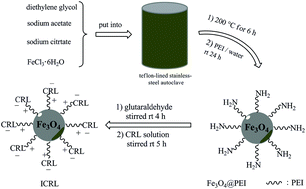Superparamagnetic Fe3O4 nanoparticles modified by water-soluble and biocompatible polyethylenimine for lipase immobilization with physical and chemical mechanisms†
Abstract
Superparamagnetic Fe3O4 nanoparticles with diameter about 18 nm were prepared by a solvothermal method. A simple and green method was used to prepare amino-rich magnetic nanoparticles. The magnetic nanoparticles were modified by polyethylenimine (PEI) which is a polycationic polymer when pH < 10. The resulted magnetic nanoparticles were activated by glutaraldehyde to obtain nanoscale support for Candida rugosa Lipase (CRL) immobilization. The CRL was immobilized on the magnetic nanoparticles covalently, as well as via ionic exchange. The structure and magnetic behavior of the magnetic nanoparticles were confirmed by transmission electron microscopy (TEM), Fourier transform infrared spectroscopy (FT-IR), and vibrating sample magnetometer (VSM). Then the properties of the immobilized CRL were investigated, and the results showed that the obtained immobilized lipase displayed good reusability and applicability. The immobilized Candida rugosa Lipase (ICRL) presented wider pH tolerance (residual activity > 80% in a pH range from 5.5 to 8.0) than free Candida rugosa Lipase (residual activity decreased rapidly when the pH values were away from 7.0). ICRL showed excellent thermal stability (the relative of ICRL > 90%) after keeping in the water bath at 50 °C for 150 min while free Candida rugosa Lipase (FCRL) was absolutely deactivated. After being reused 10 times, ICRL maintained 60% relative activity.


 Please wait while we load your content...
Please wait while we load your content...